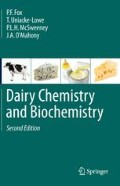Abstract
Milk is a dilute emulsion consisting of an oil/fat dispersed phase and an aqueous colloidal continuous phase. The physical properties of milk are similar to those of water but are modified by the presence of various solutes (proteins, lactose and salts) in the continuous phase and by the degree of dispersion of the emulsified and colloidal components. The principal physical properties of milk include its density, redox properties, colligative properties, surface activity buffering capacity, rheological behaviour, conductivity, thermal properties and color.
Access this chapter
Tax calculation will be finalised at checkout
Purchases are for personal use only
References
IDF. (1983). Measurement of extraneous water by the freezing point test, Bulletin 154. Brussels: International Dairy Federation.
Jenness, R., & Patton, S. (1959). Principles of dairy chemistry. New York, NY: John Wiley & Sons.
McCarthy, O. J., & Singh, H. (2009). Physico-chemical properties of milk. In P. L. H. McSweeney & P. F. Fox (Eds.), Advanced dairy chemistry—3—lactose, water, salts and vitamins (3rd ed., pp. 691–758). New York, NY: Springer.
Mulvihill, D. M. (1992). Production, functional properties and utilization of milk protein products. In P. F. Fox (Ed.), Advanced dairy chemistry—1—proteins (pp. 369–404). London, NY: Elsevier Applied Science.
Sherbon, J. W. (1988). Physical properties of milk. In N. P. Wong, R. Jenness, M. Keeney, & E. H. Marth (Eds.), Fundamentals of dairy chemistry (3rd ed., pp. 409–460). New York, NY: Van Nostrand Reinhold.
Singh, H., McCarthy, O. J., & Lucey, J. A. (1997). Physico-chemical properties of milk. In P. F. Fox (Ed.), Advanced dairy chemistry—3—lactose, water, salts and vitamins (2nd ed., pp. 469–518). London: Chapman & Hall.
Walstra, P., & Jenness, R. (1984). Dairy chemistry and physics. New York, NY: John Wiley & Sons.
Author information
Authors and Affiliations
Rights and permissions
Copyright information
© 2015 Springer International Publishing Switzerland
About this chapter
Cite this chapter
Fox, P.F., Uniacke-Lowe, T., McSweeney, P.L.H., O’Mahony, J.A. (2015). Physical Properties of Milk. In: Dairy Chemistry and Biochemistry. Springer, Cham. https://doi.org/10.1007/978-3-319-14892-2_8
Download citation
DOI: https://doi.org/10.1007/978-3-319-14892-2_8
Publisher Name: Springer, Cham
Print ISBN: 978-3-319-14891-5
Online ISBN: 978-3-319-14892-2
eBook Packages: Chemistry and Materials ScienceChemistry and Material Science (R0)

